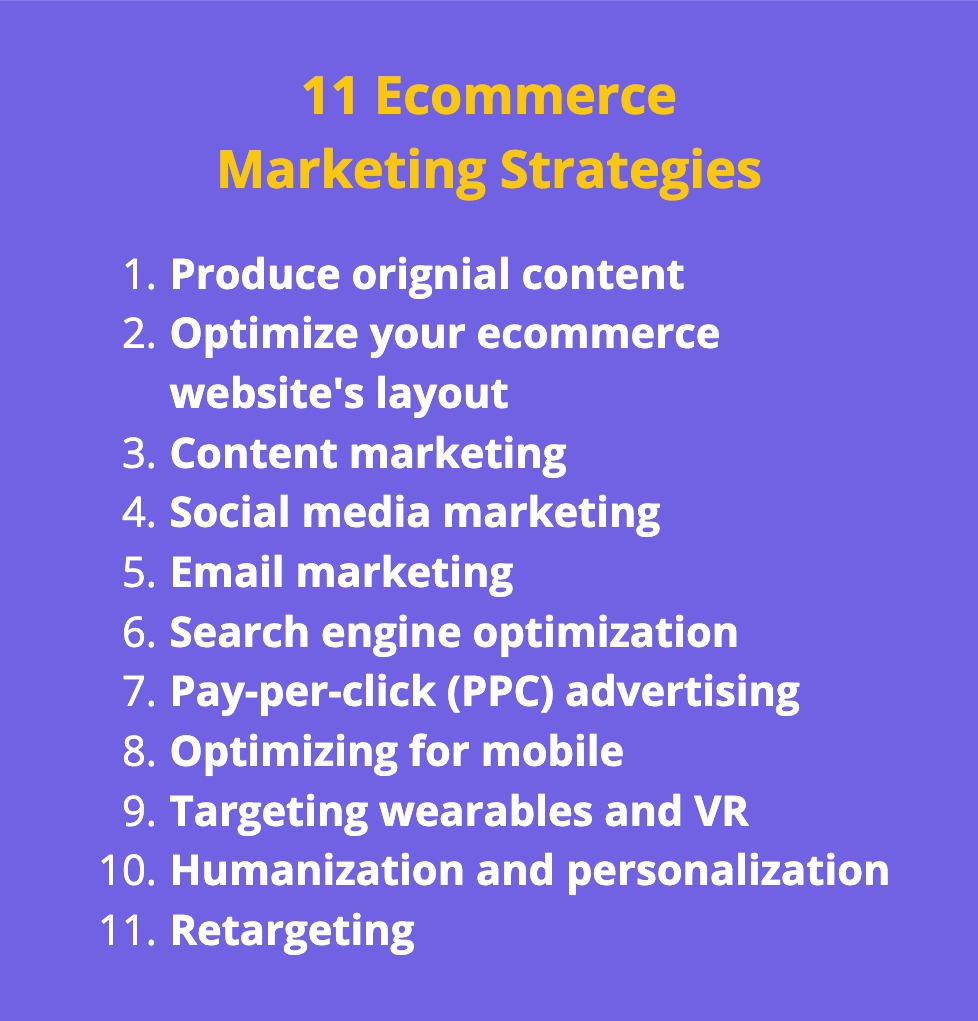In today’s digital landscape, a strong online presence is essential for e-commerce success. With fierce competition, simply having an e-commerce site is no longer enough. To stand out, you need a well-rounded digital marketing strategy that attracts, engages, and converts customers. This blog will guide you through effective digital marketing strategies for e-commerce that can drive traffic, increase sales, and build brand loyalty.

Why Digital Marketing is Crucial for E-commerce
Digital marketing allows e-commerce businesses to reach their target audience more effectively and convert website visitors into loyal customers. The right strategies can enhance your brand’s visibility, attract potential customers, and boost sales—all while providing measurable results that help you fine-tune your approach.
Essential Digital Marketing Strategies for E-commerce
1. Search Engine Optimization (SEO)
SEO is the foundation of any successful digital marketing strategy for e-commerce. A high-ranking website on search engines like Google brings in organic traffic, which is essential for long-term success. By optimizing your website for relevant keywords, you increase your chances of appearing at the top of search results when users search for products you offer.
Key SEO tactics include:
- Keyword Optimization: Research relevant keywords for product titles, descriptions, and meta tags to attract potential buyers.
- On-Page SEO: Ensure page titles, headers, and image alt texts are optimized for your target keywords.
- Technical SEO: Focus on site speed, mobile-friendliness, and URL structure to improve user experience.
- Link Building: Gain backlinks from reputable websites to build authority in your niche.
Investing in SEO may take time to show results, but it builds a strong foundation for organic traffic, helping your site gain visibility and credibility.
2. Content Marketing
Content marketing helps build trust, engages customers, and establishes your brand as an authority. By creating valuable content, you can address customer pain points, answer common questions, and guide them toward making a purchase. Some effective content marketing strategies for e-commerce include:
- Blog Posts: Write informative articles on topics relevant to your products, such as buying guides, product comparisons, and how-tos.
- Product Descriptions: Use detailed and engaging descriptions that highlight the benefits of your products, helping customers make informed purchasing decisions.
- Videos and Tutorials: Create product demos, unboxing videos, or usage tutorials to give customers a better understanding of your offerings.
Content marketing not only improves SEO but also keeps customers engaged and encourages repeat visits to your website.
3. Social Media Marketing
Social media platforms are powerful tools for connecting with your audience, increasing brand awareness, and driving traffic to your website. Choose the platforms that align with your target demographic and focus on creating engaging content. Effective social media strategies for e-commerce include:
- Product Showcases: Post images, videos, and stories showcasing your products in action.
- User-Generated Content (UGC): Encourage customers to share their photos and experiences with your products. UGC builds trust and credibility.
- Influencer Marketing: Collaborate with influencers to reach a larger audience and gain social proof.
Social media marketing is also an excellent platform for engaging with customers, answering questions, and building a loyal community around your brand.
4. Email Marketing
Email marketing is one of the most effective strategies for retaining customers and boosting repeat sales. With personalized emails, you can engage customers, nurture relationships, and encourage purchases. Key email marketing strategies include:
- Welcome Emails: Send a welcome email to new subscribers with a discount or offer to encourage their first purchase.
- Abandoned Cart Emails: Remind customers about items left in their cart to reduce cart abandonment rates.
- Product Recommendations: Send personalized product recommendations based on browsing or purchase history.
A well-crafted email marketing campaign can lead to higher conversion rates and stronger customer loyalty.

How_Facebook_Advertising_Benefits_Your_Business![]()

5. Pay-Per-Click (PPC) Advertising
PPC advertising, such as Google Ads or Facebook Ads, can bring immediate traffic to your e-commerce site. PPC campaigns allow you to target specific keywords and audiences, driving qualified traffic to your site and boosting sales.
Effective PPC strategies for e-commerce include:
- Keyword Targeting: Use relevant keywords to reach customers actively searching for products like yours.
- Retargeting Ads: Show ads to people who previously visited your website, encouraging them to return and complete a purchase.
- A/B Testing: Experiment with different ad copy, images, and offers to find the most effective combination for driving conversions.
With PPC advertising, you pay only when users click on your ads, making it a cost-effective strategy for e-commerce.
6. Affiliate Marketing
Affiliate marketing leverages third-party partners (affiliates) who promote your products in exchange for a commission on sales. This strategy broadens your reach, helps build brand awareness, and drives sales without needing a large upfront investment.
To succeed with affiliate marketing, consider:
- Selecting the Right Affiliates: Partner with influencers, bloggers, or websites with an audience that aligns with your brand.
- Offering Competitive Commissions: Motivate affiliates to actively promote your products by offering attractive commissions.
- Providing Marketing Resources: Share banners, links, and exclusive discounts that affiliates can use to promote your products effectively.
Affiliate marketing is a great way to drive sales while reducing advertising costs.
7. Conversion Rate Optimization (CRO)
CRO focuses on improving the user experience and optimizing your site to convert visitors into customers. Through A/B testing and analyzing user behavior, you can identify areas for improvement and make data-driven changes.
Common CRO strategies include:
- Simplifying the Checkout Process: Reduce the number of steps in your checkout process to prevent cart abandonment.
- Optimizing Product Pages: Use high-quality images, customer reviews, and clear calls to action to encourage purchases.
- Improving Site Speed: A faster website reduces bounce rates and keeps users engaged.
CRO helps you maximize the value of your existing traffic by making it easier for customers to complete purchases.
8. Customer Reviews and Testimonials
Online reviews and testimonials are highly influential in e-commerce, as they provide social proof and build credibility. Positive reviews help reassure potential customers about product quality and can significantly impact purchasing decisions.
Encourage customers to leave reviews by:
- Sending Post-Purchase Emails: Ask satisfied customers to leave a review.
- Offering Incentives: Provide discounts or loyalty points for leaving reviews.
- Highlighting Reviews on Product Pages: Showcase reviews directly on your product pages to build trust and transparency.
With a robust review system in place, you can improve conversions and strengthen customer trust in your brand.
Building an Integrated Digital Marketing Strategy for E-commerce
While each of these strategies can be effective on its own, combining them can create a powerful, integrated approach that drives better results. Here’s how to build an integrated digital marketing strategy:
- Set Clear Goals: Define your objectives, whether it’s increasing website traffic, boosting sales, or enhancing brand awareness.
- Identify Your Target Audience: Understand your customers’ preferences, demographics, and shopping habits to tailor your approach.
- Create a Content Calendar: Plan content for social media, blog posts, and email marketing to keep your brand consistent and engaging.
- Monitor Performance Metrics: Use tools like Google Analytics, social media insights, and email analytics to track your performance and make data-driven adjustments.
- Refine Based on Data: Regularly review your campaigns and refine your strategies based on data and customer feedback.
An integrated approach ensures that all marketing efforts work together to amplify each other, resulting in a cohesive brand experience and more impactful results.
Conclusion: Achieve E-commerce Success with Digital Marketing
Effective digital marketing strategies are essential for any e-commerce business looking to thrive in today’s competitive market. By leveraging SEO, content marketing, social media, email marketing, and other powerful strategies, you can attract new customers, retain existing ones, and drive sales. Building an integrated approach to digital marketing ensures you cover all angles, making your brand visible, engaging, and trusted.
Implementing these strategies will set your e-commerce business on a path to success, ensuring you reach your target audience, increase conversions, and grow sustainably in the digital landscape.





Leave a Reply